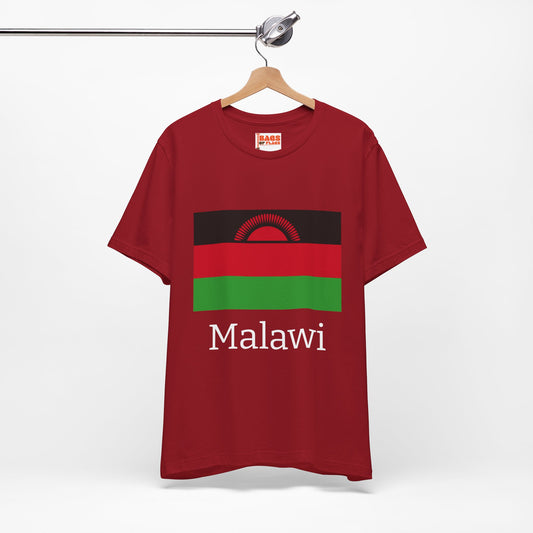-
Malawi Sweatshirt
Regular price $34.15 USDRegular priceUnit price / per -
Malawi Flag Sweatshirt
Regular price $34.15 USDRegular priceUnit price / per -
Malawi Pillow
Regular price $22.65 USDRegular priceUnit price / per -
Malawi Backpack
Regular price $59.79 USDRegular priceUnit price / per -
Malawi Leather Patch Hat
Regular price $18.85 USDRegular priceUnit price / per -
Malawi Mug
Regular price $11.65 USDRegular priceUnit price / per -
Malawi Trucker Cap
Regular price $14.90 USDRegular priceUnit price / per -
Malawi Hoodies
Regular price $34.40 USDRegular priceUnit price / per -
Malawi T-shirts
Regular price $22.79 USDRegular priceUnit price / per -
Malawi Flag Hoodies
Regular price $34.40 USDRegular priceUnit price / per -
Malawi Flag on T-shirt
Regular price $22.79 USDRegular priceUnit price / per
Collection: Malawi
The Malawi flag symbolizes the national pride and identity of the people of Malawi. Its design and colors hold significant meaning, reflecting the country's history and values. We will explore the unique significance of the Malawi flag, from its design and historical context to its symbolism and current relevance.
Overview of the Malawi Flag's Design and Colors

The flag of Malawi features a bold and meaningful composition, with three distinct horizontal stripes that convey the essence of the nation's identity. At the top, a black stripe represents the African people of Malawi, a reflection of the country's demographic. The central red stripe is a vivid reminder of the struggle for independence and the blood of those who fought for freedom. Below, a green stripe symbolizes the abundant natural beauty of Malawi, from its fertile lands to its rich vegetation, highlighting the importance of agriculture and natural resources.
The flag's centerpiece is a striking red rising sun adorned with 31 rays. This symbol is not merely decorative; it serves as a beacon of hope and progress, indicating Malawi's aspirations and the dawn of a new era following independence. This carefully chosen palette and symbols together narrate the story of Malawi's past, present, and aspirations for the future, making the flag a powerful national emblem.
The Historical Context of the Malawi Flag
Initially adopted shortly after Malawi emerged as an independent nation from British colonial rule, the flag was inaugurated on July 6, 1964. Its design, deeply inspired by the banner of the Malawi Congress Party, which was at the forefront of the country’s push for sovereignty, incorporated the motif of a rising sun to symbolize the dawn of freedom and a hopeful beginning for the newly autonomous state. However, the flag's design journey has seen moments of evolution reflective of the nation's political landscape.
In 2010, the flag underwent a controversial redesign, which replaced the rising sun with a full sun at the center, a change intended to signify Malawi’s progress since independence. This revision sparked significant debate among the populace and was seen by many as a departure from the flag’s original symbolism. The original design, with its poignant representation of hope and independence, was reinstated in 2012 following public outcry and the election of a new government, reinstating the flag's original symbolism and acknowledging the importance of historical continuity and national identity in the hearts of the Malawian people.
Symbolism Embodied in the Malawi Flag

Each element of the Malawi flag carries a wealth of meaning that transcends its visual appeal. The color black on the flag is more than a visual contrast; it stands as a symbol of unity among the African people of Malawi, emphasizing their shared heritage and strength. The red stripe cuts through the center as a color and a poignant reminder of the bloodshed during the country's fight for independence. It marks the sacrifices of those who laid down their lives for the nation's sovereignty, a testament to the bravery and resilience of Malawians. The green stripe, meanwhile, illustrates Malawi's lush landscapes and abundant resources.
It highlights the country's reliance on agriculture and the environment, underscoring the importance of nurturing and protecting these vital assets for future generations. At the flag's heart, the rising red sun is a beacon of hope and renewal. It signifies the dawn of a new era of freedom, enlightenment, and progress for Malawi, heralding a future filled with promise and aspirations. Together, these symbols weave a narrative of unity, sacrifice, abundance, and optimism, encapsulating the essence of the Malawian spirit and the nation's journey toward a brighter future.
The Malawi Flag in Today's Context
Today, the Malawi flag holds a place of honor at the heart of national identity, prominently displayed during significant events such as Independence Day celebrations, official state functions, and military ceremonies, symbolizing unity and patriotism. Its presence is a constant reminder of the country's rich history and the enduring spirit of its people. The flag's imagery is also a point of education, teaching younger generations about the sacrifices for their freedom and the importance of national pride.
Despite past controversies over its design, the Malawi flag remains a powerful emblem of national unity and progress. These debates have spurred conversations about national identity and representation, demonstrating the flag's role in engaging citizens in meaningful discussions about their country's values and future. In daily life, the flag fosters a sense of belonging among Malawians, serving as a visual representation of the nation's aspirations and achievements. Its symbolism continues to inspire, reflecting a country's collective hopes and dreams moving forward, making the Malawi flag a living piece of the nation's ongoing story.
Additional Facts and Protocols Related to the Malawi Flag
When it comes to the Malawi flag, a few critical customs and practices are followed to ensure its respectful display and handling. The flag is to be revered and cared for, especially during national holidays and significant state events. It is considered disrespectful for the flag to come into contact with the ground, symbolizing the importance of maintaining the dignity and sovereignty of the nation. Additionally, when displayed alongside flags of other countries, the Malawi flag should be positioned in a place of honor, reflecting its stature and the respect due to the nation it represents.
An interesting protocol involves how the flag is flown at half-staff. On occasions of national mourning, the flag is lowered to half-staff as a sign of respect and remembrance, a practice common to many nations but imbued with particular solemnity in Malawi.
Furthermore, the Malawi flag's design, featuring the unique motif of a rising sun, distinguishes it globally. This element not only highlights the country's aspirations and hopeful spirit but also places the Malawi flag among a select group of national flags that incorporate celestial symbols in such a meaningful way. This rare feature underscores Malawi's distinct identity and rich cultural heritage, making the flag a subject of interest and pride both domestically and internationally.






















